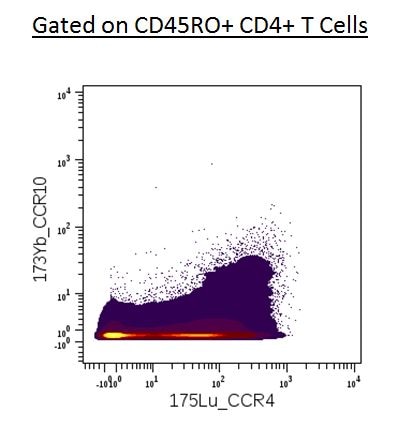Human CCR10 Antibody Summary
Gln8-Asn362
Accession # P46092
Customers also Viewed
Applications
Please Note: Optimal dilutions should be determined by each laboratory for each application. General Protocols are available in the Technical Information section on our website.
Scientific Data
 View Larger
View Larger
Detection of CCR10 in Human Blood Lymphocytes by Flow Cytometry. Human peripheral blood lymphocytes were stained with Mouse Anti-Human CD3e APC-conjugated Monoclonal Antibody (Catalog # FAB100A) and either (A) Rat Anti-Human CCR10 Monoclonal Antibody (Catalog # MAB3478) or (B) Rat IgG2AIsotype Control (Catalog # MAB006) followed by Phycoerythrin-conjugated Anti-Rat IgG Secondary Antibody (Catalog # F0105B). View our protocol for Staining Membrane-associated Proteins.
 View Larger
View Larger
Detection of Human CCR10/GPR2 by Flow Cytometry The effect of IL-21 and CD40L exposure on MEC1 and MEC2 cells.Expression of EBNA-2 and LMP-1 in IL-21 treated cells (A, B). (A) Simultaneous immunofluorescence staining of EBNA-2 (Green) and LMP-1 (Red); magnification (×100), scale bar 25 µm. Note the downregulation of EBNA-2 and upregultion of LMP-1 after IL-21 treatment. (B) Expression of EBNA-2, LMP-1 and Blimp-1 by immunoblotting; positive control: CBM1-Ral-STO, negative control: Ramos. 1.5×105 cells were loaded in the control lanes and 5×105 were loaded in both untreated and IL-21 treated MEC1 and MEC2 lanes. Note low expression of EBNA-2 and high expression of LMP-1 after IL-21 treatment and induction of Blimp-1 after IL-21 treatment. (C) Activity of the W and C promoters that regulate EBNA-2 expression and LMP-1 mRNA expression by Q-PCR. Note the difference in EBNA-2 regulation; the MEC2 cell uses both Wp and Cp while in MEC1 only Wp is active. (D) Expression of EBNA-2 and LMP-1 in cells exposed to CD40L. Simultaneous immunofluorescence staining; for details see (A). Note: EBNA-2 and LMP-1 are downregulated by CD40L in both lines. (E) CD40L induced modulation of surface marker by FACS analysis. Image collected and cropped by CiteAb from the following publication (https://dx.plos.org/10.1371/journal.pone.0106008), licensed under a CC-BY license. Not internally tested by R&D Systems.
 View Larger
View Larger
Detection of Human CCR10/GPR2 by Flow Cytometry Comparison of the MEC1 and MEC2 cells.(A) Expression of EBV encoded proteins EBNA-2 and LMP-1 by immunofluorescence; magnification (×100), scale bar 25 µm. Note: the MEC2 cells are larger. (B) Expression of EBNA-2 and LMP-1 by immunoblotting; positive control: CBM1-Ral-STO, negative control: Ramos. 1.5×105 cells were loaded in control lanes and 5×105 were loaded in MEC1 and MEC2 lanes. Note MEC2 expresses higher amount of EBNA-2. (C) Expression of Bright and BARF1 by Q-PCR. (D) FACS analysis of surface markers that are differently expressed in the 2 lines. Image collected and cropped by CiteAb from the following publication (https://dx.plos.org/10.1371/journal.pone.0106008), licensed under a CC-BY license. Not internally tested by R&D Systems.
Preparation and Storage
- 12 months from date of receipt, -20 to -70 °C as supplied.
- 1 month, 2 to 8 °C under sterile conditions after reconstitution.
- 6 months, -20 to -70 °C under sterile conditions after reconstitution.
Background: CCR10
CCR10 is a G protein-linked seven transmembrane domain protein expressed by T cells and B cell subsets that function as a receptor for CCL27. CCR10 mediates lymphocyte migration to the skin and mucosa, and its expression correlates with the metastatic capacity of melanomas.
Product Datasheets
Citations for Human CCR10 Antibody
R&D Systems personnel manually curate a database that contains references using R&D Systems products. The data collected includes not only links to publications in PubMed, but also provides information about sample types, species, and experimental conditions.
6
Citations: Showing 1 - 6
Filter your results:
Filter by:
-
Cancer cell chemokines direct chemotaxis of activated stellate cells in pancreatic ductal adenocarcinoma
Authors: Ishan Roy, Kathleen A. Boyle, Emily P. Vonderhaar, Noah P. Zimmerman, Egal Gorse, A. Craig Mackinnon et al.
Laboratory Investigation
-
Skin Metabolites Define a New Paradigm in the Localization of Skin Tropic Memory T Cells.
Authors: McCully M, Collins P, Hughes T, Thomas C, Billen J, O'Donnell V, Moser B
J Immunol, 2015-05-22;195(1):96-104.
Species: Human
Sample Types: Whole Cells
Applications: Flow Cytometry -
Microbe-specific unconventional T cells induce human neutrophil differentiation into antigen cross-presenting cells.
Authors: Davey M, Morgan M, Liuzzi A, Tyler C, Khan M, Szakmany T, Hall J, Moser B, Eberl M
J Immunol, 2014-08-27;193(7):3704-3716.
Species: Human
Sample Types: Whole Cells
Applications: Flow Cytometry -
The MEC1 and MEC2 lines represent two CLL subclones in different stages of progression towards prolymphocytic leukemia.
Authors: Rasul E, Salamon D, Nagy N, Leveau B, Banati F, Szenthe K, Koroknai A, Minarovits J, Klein G, Klein E
PLoS ONE, 2014-08-27;9(8):e106008.
Species: Human
Sample Types: Whole Cells
Applications: Flow Cytometry -
IL-1beta promotes the differentiation of polyfunctional human CCR6+CXCR3+ Th1/17 cells that are specific for pathogenic and commensal microbes.
Authors: Duhen T, Campbell D
J Immunol, 2014-06-02;193(1):120-9.
Species: Human
Sample Types: Whole Cells
Applications: Flow Cytometry -
Vitamins A and D are potent inhibitors of cutaneous lymphocyte-associated antigen expression.
Authors: Yamanaka K, Dimitroff CJ, Fuhlbrigge RC, Kakeda M, Kurokawa I, Mizutani H, Kupper TS
J. Allergy Clin. Immunol., 2007-10-01;121(1):148-157.e3.
Species: Human
Sample Types: Whole Cells
Applications: Flow Cytometry
FAQs
No product specific FAQs exist for this product, however you may
View all Antibody FAQsReviews for Human CCR10 Antibody
Average Rating: 4 (Based on 1 Review)
Have you used Human CCR10 Antibody?
Submit a review and receive an Amazon gift card.
$25/€18/£15/$25CAN/¥75 Yuan/¥2500 Yen for a review with an image
$10/€7/£6/$10 CAD/¥70 Yuan/¥1110 Yen for a review without an image
Filter by:













